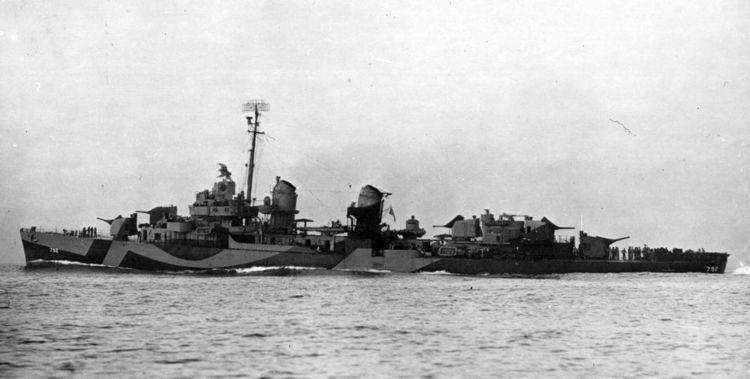Commissioned 27 November 1943 Construction started 21 February 1943 Length 115 m | Laid down 21 February 1943 Displacement 2,050 tons Launched 1 August 1943 Beam 12 m | |
 | ||
Builder Bethlehem Shipbuilding Corporation | ||
USS Callaghan (DD-792), a Fletcher-class destroyer, was a ship of the United States Navy named for Rear Admiral Daniel J. Callaghan (1890–1942), who was killed in action in the bitter Naval Battle of Guadalcanal. He was posthumously awarded the Medal of Honor for extraordinary heroism during the action in which he gave his life.
Contents

Callaghan was launched 1 August 1943 by Bethlehem Steel Co., San Pedro, Calif.; sponsored by Mrs. D. J. Callaghan; commissioned 27 November 1943, Commander F. J. Johnson in command; and reported to the Pacific Fleet.
Service History
Callaghan sailed from the West Coast 5 February 1944 to plunge into action with fast-striking 5th Fleet in smashing air raids on the Palaus, Yap, Ulithi, and Woleai from 30 March to 1 April. Based on Manus in April, Callaghan supported the Hollandia operation through important services as picket ship during air strikes, and screening the valuable tankers.

From June to August 1944, Callaghan provided screen for escort carriers softening up, and later supporting the invasions of Saipan, Tinian, and Guam. At Saipan, Callaghan's guns joined in driving off a heavy Japanese air attack on 17 June, helping splash three enemy planes. Fanshaw Bay was struck by a bomb in this attack, and Callaghan shielded the crippled escort carrier safely back to Eniwetok. Late in August Callaghan began operations as escort for air strikes on the Palaus, Mindanao, Luzon, and the Central Philippines in support of the invasion of the Palaus, a stepping stone to the Philippines.

With the long-awaited return to the Philippines scheduled for mid-October 1944, Callaghan steamed in the screen of the carrier force conducting essential preliminary neutralization of Japanese airfields in Formosa and Okinawa. During a heavy enemy air attack on 14 October, Callaghan joined in downing several planes. Sailing on to stand guard off the invasion area on Leyte, Callaghan's force contributed air power in the decisive Battle for Leyte Gulf, which insured the Allied advance in the Philippines against the desperate Japanese efforts to break up the landings. After pursuing Japanese cripples fleeing north, Callaghan returned to support the Philippine operations, in company with the 3rd Fleet, for air strikes on Luzon. En route on 3 November, Reno was torpedoed, and Callaghan stood by to protect the stricken light cruiser until relief forces arrived, when Callaghan was able to rejoin her group for the strikes. Through December, she participated in more air strikes on the Central Philippines, and in January 1945, the destroyer sailed with the 3rd Fleet for air raids on Formosa, Luzon, Indo-China, Hong Kong, and the Nansei Shoto.

Through the following months, Callaghan operated at the same active pace, screening carrier strikes pounding Iwo Jima, Okinawa, and the Tokyo area. Callaghan assisted in sinking a Japanese picket boat on 18 February, and on 3 March joined the bombardment of Parece Vela. In late March she joined a battleship force at Ulithi, and from this base sailed for the bombardment preceding the invasion of Okinawa, where she threw harassing fire ashore during the night of 26 March. This initiated prolonged fire support and screening duty in the dangerous waters off Okinawa during which, in addition to invaluable aid to the troops, Callaghan joined in the sinking of a Japanese midget submarine and in the kill of three dive bombers.
Fate
On 9 July 1945, Callaghan took station on the embattled radar picket line, where on 28 July she drove off an attacking wood-and-fabric Yokosuka K5Y biplane with well-directed fire. The aircraft survived this first approach because the proximity fuses were ineffective against its wooden fuselage. The plane, skimming low and undetected, returned to strike Callaghan on the starboard side. It exploded and one of the plane's bombs penetrated the after engine room. The destroyer flooded, and the fires which ignited antiaircraft ammunition prevented nearby ships from rendering aid. Callaghan sank at 02:35, 28 July 1945, with the loss of 47 members of her crew. She was the last Allied ship sunk by a kamikaze attack during the war.
Awards
Callaghan received eight battle stars for World War II service.
